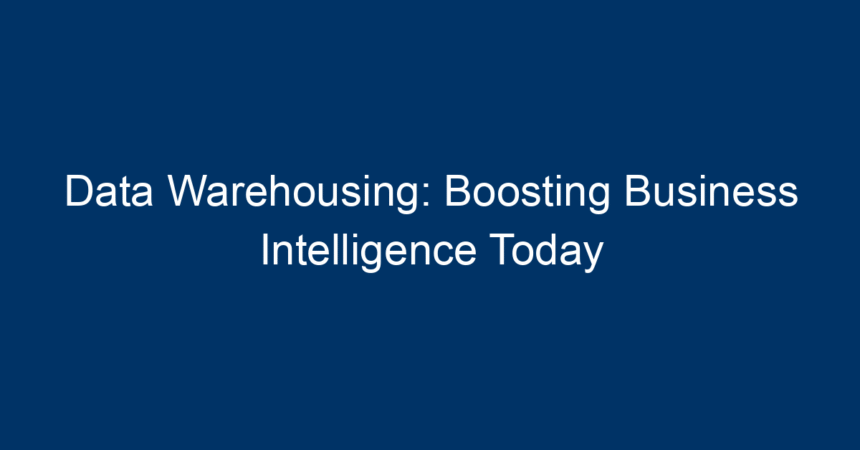In the rapid-paced world of digital transformation, businesses are constantly seeking ways to harness the power of data to gain a competitive edge. One of the most effective strategies for managing and interpreting massive amounts of data is data warehousing. This essential tool has emerged as a cornerstone of business intelligence, allowing organizations to analyze historical and real-time data to drive decision-making and strategy. Let’s dive into the intricacies of data warehousing, its importance in today’s business landscape, and actionable insights for implementation.
What is Data Warehousing?
Data warehousing refers to the process of collecting, storing, and managing large volumes of data from various sources in a centralized repository. This structured environment is optimized for retrieval and analysis, making it a crucial element of effective business intelligence systems.
Key Characteristics of Data Warehousing
- Centralization: By aggregating data from multiple sources, data warehousing creates a single source of truth that can be used for reporting and analysis.
- Historical Data Storage: Data warehouses retain historical data, enabling businesses to track trends and performance over time.
- Data Integrity and Quality: High data quality is ensured as data is cleaned, transformed, and standardized before being loaded into the warehouse.
- Optimized for Querying: Unlike transactional systems, data warehouses are designed for complex queries and analysis, ensuring faster response times.
The Role of Data Warehousing in Business Intelligence
1. Enhanced Decision-Making
Data-driven decision-making is critical in today’s business environment. A data warehouse provides executives and managers with easy access to reliable data analytics. By leveraging tools like ETL (Extract, Transform, Load), businesses can convert raw data from various systems into actionable insights that inform strategic decisions.
2. Improved Reporting Capabilities
With the ability to consolidate data from different departments—finance, sales, marketing, and more—a data warehouse enhances reporting capabilities. Organizations can generate comprehensive reports that provide a holistic view of their performance, helping them to identify opportunities for improvement.
3. Trend Analysis and Forecasting
Data warehousing facilitates historical analysis, allowing companies to identify patterns and trends. Businesses can utilize these insights for forecasting future demands, optimizing inventory levels, and improving customer satisfaction.
4. Enhanced Customer Insights
Understanding customer behavior is vital for tailoring marketing strategies. Data warehousing enables companies to analyze customer interactions and transactions extensively, leading to more effective targeted campaigns and improved client relationships.
Technology Underpinning Data Warehousing
Data Integration Tools
Effective data warehousing relies on robust data integration tools. These tools ensure that data from disparate sources (such as CRM systems, ERP solutions, and social media platforms) can be gathered and transformed consistently.
Cloud vs. On-Premises Data Warehousing
Businesses can choose between cloud-based or on-premises data warehouses.
-
Cloud Data Warehousing offers scalability, flexibility, and reduced infrastructure costs. Companies like Amazon Redshift, Google BigQuery, and Snowflake are leading the charge in this space.
- On-Premises Solutions provide greater control over the data environment, catering to organizations with strict regulatory compliance needs.
Data Architecture
A well-thought-out data architecture is crucial for any data warehousing initiative. Common architectures include the Kimball and Inmon models. Each has distinct approaches to structuring and organizing data, influencing how businesses execute their analytics strategies.
Challenges in Data Warehousing
While data warehousing offers numerous benefits, it does come with challenges that organizations must navigate.
1. Data Quality Issues
Inconsistent data sources can lead to quality issues that impede accurate analysis. Regular auditing and data cleansing are necessary to ensure that the data remains reliable.
2. Slow ETL Processes
Complex ETL processes can lead to lengthy delays in data availability. Businesses must invest in efficient ETL tools to streamline operations and improve the speed at which insights can be derived.
3. Cost Management
Implementing a data warehouse can be expensive, particularly for smaller businesses. It’s essential to carefully assess the investment against the projected ROI.
4. User Adoption
There might be resistance to adopting new systems like data warehouses within organizations. Comprehensive training and clear communication of benefits are critical for user buy-in.
Best Practices for Implementing Data Warehousing
-
Define Clear Goals: Outline the specific goals your organization aims to achieve with a data warehouse. Clear objectives can guide the design and implementation process.
-
Use a Phased Approach: Implement the data warehouse in phases to manage costs and complexity effectively. Start with essential data sources and gradually expand.
-
Invest in Training: Ensure that staff members understand how to leverage the data warehouse effectively. Ongoing training and resources can facilitate seamless integration.
-
Monitor Performance: Set up key performance indicators (KPIs) to track the data warehouse’s performance continuously. Regular assessments can help identify potential bottlenecks or quality issues.
- Ensure Data Governance: Establish data governance practices to maintain data quality, security, and compliance. This will safeguard the data warehouse’s integrity over time.
The Future of Data Warehousing
As we move further into the era of big data, the future of data warehousing is poised for significant changes. Emerging technologies such as AI and machine learning are becoming increasingly integrated into data warehousing solutions. These technologies will enhance data analysis capabilities, enabling businesses to derive insights at unprecedented speeds.
Real-time Data Warehousing
The demand for real-time insights is growing. Real-time data warehousing solutions will allow organizations to access and analyze streaming data instantaneously, adapting to market changes on the fly.
Advanced Analytics
With ongoing advancements in analytics tools, organizations can expect more sophisticated capabilities. These tools will allow users to conduct deeper analyses, uncovering nuances that traditional methods might overlook.
Conclusion: Making Data Warehousing Work for You
In today’s data-driven landscape, data warehousing stands as a foundational element of successful business intelligence strategies. By centralizing and optimizing data management processes, organizations can enhance their decision-making capabilities, improve reporting, and strengthen customer insights.
To reap the full benefits of data warehousing, businesses should focus on establishing clear goals, investing in technology, and ensuring data quality. Embracing a phased approach combined with ongoing training will enhance user adoption, ultimately leading to improved business performance.
As you consider implementing or enhancing your data warehousing strategies, remember that the pursuit of intelligent data management is an ongoing journey. Staying ahead of trends and continually refining your approach will not only position your organization for success but also empower you to make timely, informed decisions that drive growth.
Whether you are a small business or a large enterprise, the insights gained through effective data warehousing can propel your business to new heights. Don’t wait—start leveraging the power of data today!




